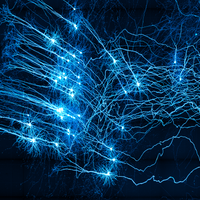Login
Subscribecell & molecular biology

Fastest-Ever Cell Contractions Observed in Primitive Invertebrate
Abby Olena, PhD | Dec 13, 2018 | 4 min read
The microscopic marine animal Trichoplax adhaerens may use rapid changes in cell shape to avoid being ripped apart by forces in the ocean.

Opinion: The Central Dogma of Mitochondrial Genetics Needs Rewriting
John D. Loike | Dec 12, 2018 | 3 min read
The recent discovery of 17 people who have inherited maternal and paternal lines of mitochondrial DNA has major ramifications for medical and ancestry research.

Review Preview
The Scientist | Dec 10, 2018 | 1 min read
Hear this month’s Scientist to Watch, Prachee Avasthi, describe the preprint journal review club she started at the University of Kansas Medical Center.

Marianne the Mentor
The Scientist | Dec 10, 2018 | 1 min read
Meet Caltech cell and molecular biologist Marianne Bronner, this month’s profilee, and hear her take on encouraging the next generation of researchers.

Prachee Avasthi Explores How Cells Build and Maintain Cilia
Shawna Williams | Dec 1, 2018 | 3 min read
The University of Kansas professor is also known for her leadership among early-career researchers.

Bacteria Harbor Geometric “Organelles”
Amber Dance | Dec 1, 2018 | 10+ min read
Microbes, traditionally thought to lack organelles, get a metabolic boost from geometric compartments that act as cauldrons for chemical reactions. Bioengineers are eager to harness the compartments for their own purposes.

Infographic: The Fate of Fat Cells During Breastfeeding
Kerry Grens | Dec 1, 2018 | 1 min read
See how the cells accommodate milk production in mouse mammary tissue.

Infographic: Bacterial Microcompartments Basics
Amber Dance | Dec 1, 2018 | 1 min read
These icosahedral structures are composed of proteins with unique geometric properties, which enable bacteria to employ them in a variety of situations.

Contributors
The Scientist Staff | Dec 1, 2018 | 3 min read
Meet some of the people featured in the December 2018 issue of The Scientist.

Infographic: What Are Membraneless Organelles?
Michael Crabtree and Tim Nott | Dec 1, 2018 | 2 min read
The physical principles that dictate the formation of these subcellular compartments are simple, but they dictate the organelles’ complex functions.

Caught on Camera
The Scientist | Dec 1, 2018 | 1 min read
Selected Images of the Day from the-scientist.com

Discovery’s Crest: A Profile of Marianne Bronner
Anna Azvolinsky | Dec 1, 2018 | 8 min read
Studying how neural crest cells journey through the embryo, this Caltech developmental biologist has revealed how they form major cell types, including peripheral neurons, bone, and smooth muscle.

Fat Cells Shrink to Make Room for Milk in Breastfeeding Mouse Moms
Kerry Grens | Dec 1, 2018 | 2 min read
Adipocytes lose their lipids and reprogram themselves into stem cells during lactation, then turn back into fat cells after pups wean.

These Organelles Have No Membranes
Michael Crabtree and Tim Nott | Dec 1, 2018 | 10+ min read
From making ribosomes to protecting the integrity of the genome, these membraneless compartments play important roles in the cell. Their behavior is rooted in basic physics.

How K2 and Other Synthetic Cannabinoids Got Their Start in the Lab
Ashley Yeager | Nov 27, 2018 | 7 min read
Originally intended for basic neuroscience research, the drugs were ultimately hijacked for illicit recreational use.

Image of the Day: Interloper Cells
Ashley Yeager | Nov 16, 2018 | 1 min read
In kidney organoids, brain and muscle cells also develop.

Image of the Day: Drop Set
Catherine Offord | Nov 13, 2018 | 1 min read
Liquid-like droplets containing DNA and proteins provide a model for researchers to study membraneless organization in the cell.

Image of the Day: Retinal Transplant
Kerry Grens | Nov 7, 2018 | 1 min read
Blind rats are made to see after sheets of cells implanted into their eyes make themselves at home.

Revealed: New Cortical Neuron Types
Ashley P. Taylor | Oct 31, 2018 | 2 min read
A pair of mouse studies describes neuronal subpopulations not identified before and some of their functions.
